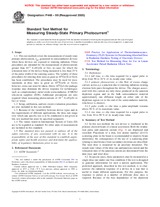Wir benötigen Ihre Einwilligung zur Verwendung der einzelnen Daten, damit Sie unter anderem Informationen zu Ihren Interessen einsehen können. Klicken Sie auf "OK", um Ihre Zustimmung zu erteilen.
ASTM F448-99(2005)
Test Method for Measuring Steady-State Primary Photocurrent
Automatische name übersetzung:
Test Methode zur Messung Stationäre Primäre Photo
NORM herausgegeben am 1.1.2005
Informationen über die Norm:
Bezeichnung normen: ASTM F448-99(2005)
Anmerkung: UNGÜLTIG
Ausgabedatum normen: 1.1.2005
SKU: NS-55344
Zahl der Seiten: 7
Gewicht ca.: 21 g (0.05 Pfund)
Land: Amerikanische technische Norm
Kategorie: Technische Normen ASTM
Die Annotation des Normtextes ASTM F448-99(2005) :
Keywords:
hardness assurance, ionizing radiation, photocurrent, primary photocurrent, semiconductor testing, ICS Number Code 31.260 (Optoelectronics. Laser equipment)
Ergänzende Informationen
| Significance and Use | ||||
|
The steady-state photocurrent of a simple p-n junction diode is a directly measurable quantity that can be directly related to device response over a wide range of ionizing radiation. For more complex devices the junction photocurrent may not be directly related to device response. Zener Diode— In this device, the effect of the photocurrent on the Zener voltage rather than the photocurrent itself is usually most important. The device is most appropriately tested while biased in the Zener region. In testing Zener diodes or precision voltage regulators, extra precaution must be taken to make certain the photocurrent generated in the device during irradiations does not cause the voltage across the device to change during the test. Bipolar Transistor—As device geometries dictate that photocurrent from the base-collector junction be much greater than current from the base-emitter junction, measurements are usually made only on the collector-base junction with emitter open; however, sometimes, to obtain data for computer-aided circuit analysis, the emitter-base junction photocurrent is also measured. Junction Field-Effect Device—A proper photocurrent measurement requires that the source be shorted (dc) to the drain during measurement of the gate-channel photocurrent. In tetrode-connected devices, the two gate-channel junctions should be monitored separately. Insulated Gate Field-Effect Device—In this type of device, the true photocurrent is between the substrate and the channel, source, and drain regions. A current which can generate voltage that will turn on the device may be measured by the technique used here, but it is due to induced conductivity in the gate insulator and thus is not a junction photocurrent. |
||||
| 1. Scope | ||||
|
1.1 This test method covers the measurement of steady-state primary photocurrent, Ipp, generated in semiconductor devices when these devices are exposd to ionizing radiation. These procedures are intended for the measurement of photocurrents greater than 10-9 A-s/Gy(Si or Ge), in cases for which the relaxation time of the device being measured is less than 25% of the pulse width of the ionizing source. The validity of these procedures for ionizing dose rates as great as 108Gy(Si or Ge)/s has been established. The procedures may be used for measurements at dose rates as great as 1010Gy(Si or Ge)/s; however, extra care must be taken. Above 108Gy/s the package response may dominate the device response for technologies such as complementary metal-oxide semiconductor, (CMOS)/silicon-on sapphire (SOS). Additional precautions are also required when measuring photocurrents of 10-9 A-s/Gy(Si or Ge) or lower. 1.2 Setup, calibration, and test circuit evaluation procedures are also included in this test method. 1.3 Because of the variability between device types and in the requirements of different applications, the dose rate range over which any specific test is to be conducted is not given in this test method but must be specified separately. 1.4 The values state in International System of Units (SI) are to be regarded as the standard. No other units of measurement are included in this standard. 1.5 This standard does not purport to address all of the safety concerns, if any, associated with its use. It is the responsibility of the user of this standard to establish appropriate safety and health practices and determine the applicability of regulatory limitations prior to use. |
||||
| 2. Referenced Documents | ||||
|
Empfehlungen:
Aktualisierung der technischen Normen
Wollen Sie sich sicher sein, dass Sie nur die gültigen technischen Normen verwenden?
Wir bieten Ihnen eine Lösung, die Ihnen eine Monatsübersicht über die Aktualität der von Ihnen angewandten Normen sicher stellt.
Brauchen Sie mehr Informationen? Sehen Sie sich diese Seite an.




 Cookies
Cookies
